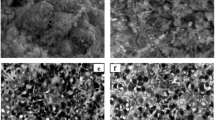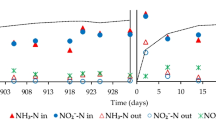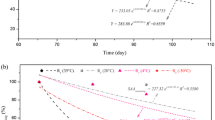Abstract
Deposit of useful microorganisms in culture collections requires long-term preservation and successful reactivation techniques. The goal of this study was to develop a simple preservation protocol for the long-term storage and reactivation of the anammox biomass. To achieve this, anammox biomass was frozen or lyophilized at two different freezing temperatures (−60°C and in liquid nitrogen (−200°C)) in skim milk media (with and without glycerol), and the reactivation of anammox activity was monitored after a 4-month storage period. Of the different preservation treatments tested, only anammox biomass preserved via freezing in liquid nitrogen followed by lyophilization in skim milk media without glycerol achieved stoichiometric ratios for the anammox reaction similar to the biomass in both the parent bioreactor and in the freshly harvested control treatment. A freezing temperature of −60°C alone, or in conjunction with lyophilization, resulted in the partial recovery of the anammox bacteria, with an equal mixture of anammox and nitrifying bacteria in the reactivated biomass. To our knowledge, this is the first report of the successful reactivation of anammox biomass preserved via sub-zero freezing and/or lyophilization. The simple preservation protocol developed from this study could be beneficial to accelerate the integration of anammox-based processes into current treatment systems through a highly efficient starting anammox biomass.




Similar content being viewed by others
References
Abeliovich A, Vonhak A (1992) Anaerobic metabolism of Nitrosomonas europaea. Arch Microbiol 158:267–270
Abma WR, Mulder JW, van Loosdrect MCM, Strous M, Tokutomi T (2005) Anammox demostration on full scale in Rotterdam. Paper presented at the Third IWA Leading-Edge Conference and Exhibition on Water and Wastewater Treatment Technologies, Sapporo, Japan
Ahn YH (2006) Sustainable nitrogen elimination biotechnologies: a review. Process Biochem 41:1709–1721
Akunna JC, Bizeau C, Moletta R (1993) Nitrate and nitrite reductions with anaerobic sludge using various carbon sources: glucose, glycerol, acetic acid, lactic acid and methanol. Water Res 27(8):1303–1312. doi:https://doi.org/10.1016/0043-1354(93)90217-6
Altschul SF, Madden TL, Schaffer AA, Zhang J, Zhang Z, Miller W, Lipman DJ (1997) Gapped BLAST and PSI-BLAST: a new generation of protein database search programs. Nucleic Acids Res 25:3389–3402
Amann R, Krumholz L, Stahl DA (1990) Fluorescent-oligonucleotide probing of whole cells for determinative, phylogenetic, and environmental studies in microbiology. J Bacteriol 172:762–770
APHA (1998) Standard methods for the examination of water and wastewater, 20th edn. American Public Health Association, Washington
Arrigo RA (2005) Marine microorganisms and global nutrient cycles. Nature 437:349–355
Bock E, Schmidt I, Stüven R, Zart D (1995) Nitrogen loss caused by denitrifying Nitrosomonas cells using ammonium or hydrogen as electron donors and nitrite as electron acceptor. Arch Microbiol 163(1):16–20. doi:https://doi.org/10.1007/bf00262198
CABRI (1998) Laboratory procedures for microorganisms. Common Access to Biological Resources and Information (CABRI). Available at http://www.cabri.org/guidelines/micro-organisms/M300Ap3.html. Accessed 1 February 2009
Dalsgaard T, Thamdrup B, Canfield DE (2005) Anaerobic ammonium oxidation (anammox) in the marine environment. Res Microbiol 156:457–464
Dosta J, Fernandez I, Vasquez-Padin JR, Mosquera-Corral A, Campos JL, Mata-Alvarez J, Mendez R (2008) Short- and long-term effects of temperature on the anammox process. J Hazard Mater 154:688–693
Furukawa K, Rouse J, Yoshida N, Hatanaka H (2003) Mass cultivation of anaerobic ammonium-oxidizing sludge using novel biomass carrier. J Chem Eng Jpn 36:1136–1169
Hippen A, Rosenwinkel K, Baumgarten G, Seyfried CF (1997) Aerobic deammonification: a new experimence in treatment of wastewaters. Water Sci Technol 35:111–120
Hsai T-H, Feng Y-J, Ho C-M, Chou W-P, Tseng S-K (2008) PVA-alginate immobilizaed cells for anaerobic ammonium oxidation (anammox) process. J Ind Microbiol Biotechnol 35:721–727
Innerebner G, Insam H, Franke-Whittle IH, Wett B (2007) Identification of anammox bacteria in a full-scale deammonification plant making use of anaerobic ammonia oxidation. Syst Appl Microbiol 30:408–412
Isaka K, Date Y, Sumino T, Yoshie S, Tsuneda S (2006) Growth characteristic of anaerobic ammonium-oxidizing bacteria in an anaerobic biological filtrated reactor. Appl Microbiol Biotechnol 70:47–52
Isaka K, Date Y, Kimura Y, Sumino T, Tsuneda S (2008) Nitrogen removal performance using anaerobic ammonium oxudation at low temperatures. FEMS Microbiol Lett 282:32–38
Jetten MSM, Strous M, van de Pas-Schoonen KT, Schalk J, van Dongen UGJM, van de Graaf AA, Logemann S, Muyzer G, van Loosdrecht MCM, Kuenen JG (1999) The anaerobic oxidation of ammonium. FEMS Microbiol Rev 22:421–437
Kindaichi T, Tsushima I, Ogasawara Y, Shimokawa M, Ozaki N, Satoh H, Okabe S (2007) In situ activity and spatial organization of anaerobic ammonium-oxidizing (anammox) bacteria in biofilms. Appl Environ Microbiol 73(15):4931–4939. doi:https://doi.org/10.1128/aem.00156-07
Kuai LP, Verstraete W (1998) Ammonium removal by the oxygen-limited autotrophic nitrification–denitrification system. Appl Environ Microbiol 64:4500–4506
Kuenen JG (2008) Anammox bacteria: from discovery to application. Nat Rev Microbiol 6:320–326
Laurin V, Labbe V, Juteau P, Parent S, Villemur R (2006) Long-term storage conditions for carriers with denitrifying biomass of the fluidized, methanol-fed denitrification reactor of the Montreal Biodome, and the impact on denitrifying activity and bacterial population. Water Res 40:1836–1840
Lindsay M, Webb R, Strous M, Jetten M, Butler M, Forde R, Fuerst J (2001) Cell compartmentalisation in planctomycetes: novel types of structural organisation for the bacterial cell. Arch Microbiol 175(6):413–429. doi:https://doi.org/10.1007/s002030100280
Mobarry BK, Wagner M, Urbain V, Rittmann BE, Stahl DA (1996) Phylogenetic probes for analyzing abundance and spatial organization of nitrifying bacteria. Appl. Environ. Microbiol. 62:2156–2162
Mulder A, van de Graaf AA, Robertson LA, Kuenen JG (1995) Anaerobic ammonium oxudation discovered in a denitrifying fluidized bed reactor. FEMS Microbiol Ecol 16:177–184
Rysgaard S, Glud RN (2004) Anaerobic N-2 production in Arctic sea ice. Limnol Oceanogr 49:86–94
SAS (2008) SAS, 92nd edn. SAS Institute, Inc, Cary
Schmid MC, Maas B, Dapenda A, van de Pas-Schoonen KT, van de Vossenberg J, Kartal B, van Niftrik L, Schmidt I, Cirpus I, Kuenen JG, Wagner M, Sinninghe Damst JS, Kuypers M, Revsbech NP, Mendez R, Jetten MSM, Strous M (2005) Biomarkers for in site detection of anaerobic ammonium-oxidizing (anammox) bacteria. Appl Environ Microbiol 71(4):1677–1684
Schmidt I, Hermelink C, van de Pas-Schoonen K, Strous M, den Camp HJO, Kuenen JG, Jetten MSM (2002a) Anaerobic ammonia oxidation in the presence of nitrogen oxides (NOx) by two different lithotrophs. Appl Environ Microbiol 68(11):5351–5357. doi:https://doi.org/10.1128/aem.68.11.5351-5357.2002
Schmidt I, Sliekers O, Schmid M, Cirpus I, Strous M, Bock E, Kuenen JG, Jetten MSM (2002b) Aerobic and anaerobic ammonia oxidizing bacteria—competitors or natural partners? FEMS Microbiol Ecol 39:175–181
Strous M, Heijnen JJ, Kuenen JG, Jetten MSM (1998) The sequencing batch reactor as a powerful tool for the study of slowly growing anaerobic ammonium-oxidizing microorganisms. Appl Microbiol Biotechnol 50:589–596
Strous M, Kuenen JG, Jetten MSM (1999) Key physiology of anaerobic ammonium oxidation. Appl Environ Microbiol 65(7):3248–3250
Third KA, Sliekers AO, Kuenen JG, Jetten MSM (2001) The CANON system (completely autotrophic nitrogen removal over nitrite) under ammonium limitation: interaction and competition between three groups of bacteria. Syst Appl Microbiol 24:588–596
Tsushima I, Kindaichi T, Okabe S (2007) Quantification of anaerobic ammonium-oxidizing bacteria in enrichment cultures by real-time PCR. Water Res 41:785–794
van Dongen UGJM, Jetten MSM, van Loosdrecht MCM (2001) The SHARON-anammox process for the treatment of ammoinum rich wastewater. Water Sci Technol 44:154–160
van Niftrik LA, Fuerst JA, Sinninghe Damst JS, Kuenen JG, Jetten MSM, Strous M (2004) The anammoxosome: an introcytoplasmic compartment in anammox bacteria. FEMS Microbiol Lett 23:7–13
Vanotti MB, Szogi AA, Rothrock MJ Jr (2011) Novel anammox bacterium isolate. US Patent Appl. S/N 13/013,874, filed 1/26/2011. US Patent and Trademark Office, Washington
Vlaeminck SE, Geets J, Vervaeren H, Boon N, Verstraete W (2007) Reactivation of aerobic and anaerobic ammonium oxidizers in OLAND biomass after long-term storage. Appl Microbiol Biotechnol 74:1376–1384
Vogelsang C, Gollembiewski K, Ostgaard K (1998) Effect of preservation techniques on the regeneration of gel entrapped nitrifying sludge. Water Res 33:164–168
Wagner M, Rath G, Koops HP, Flood J, Amann R (1996) In situ analysis of nitrifying bacteria in sewage treatment plants. Water Sci. Technol. 34:237–244
Ward N, Staley JT, Fuerst JA, Giovannoni S, Schlesner H, Stackebrandt W (2006) The Order Planctomycetales, including the genera Planctomyces, Pirellula, Gemmata and Isosphaera and the Candidatus genera Brocadia, Kuenenia, and Scalindua. In: Dworkin M, Falkow S, Rosenberg E, Schleifer K-H, Stackebrandt E (eds) The Prokaryotes, vol 7, 3rd edn. Springer, New York, pp 757–793
Weber S, Stubner S, Conrad R (2001) Bacterial populations colonizing and degrading rice straw in anoxic paddy soil. Appl Environ Microbiol 67(3):1318–1327. doi:https://doi.org/10.1128/aem.67.3.1318-1327.2001
WIPO (1980) Budapest Treaty on the international Recognition of the deposit of microorganisms for the purposes of patent procedure. United Nations World Intellectual Property Organization (WIPO). Available at http://www.wipo.int/treaties/en/registration/budapest. Accessed 3 February 2011
Acknowledgements
The authors would like to thank Aprel Ellison, Kirsten Hiortdahl, and Laura Smith for their assistance in liquid sample and FISH analyses. This research was part of USDA-ARS National Program 206: Manure and By-Product Utilization: ARS Project 6657-13630-003-00D “Innovative Animal Manure Treatment Technologies for Enhanced Environmental Quality.”
Author information
Authors and Affiliations
Corresponding author
Rights and permissions
About this article
Cite this article
Rothrock, M.J., Vanotti, M.B., Szögi, A.A. et al. Long-term preservation of anammox bacteria. Appl Microbiol Biotechnol 92, 147–157 (2011). https://doi.org/10.1007/s00253-011-3316-1
Received:
Revised:
Accepted:
Published:
Issue Date:
DOI: https://doi.org/10.1007/s00253-011-3316-1




